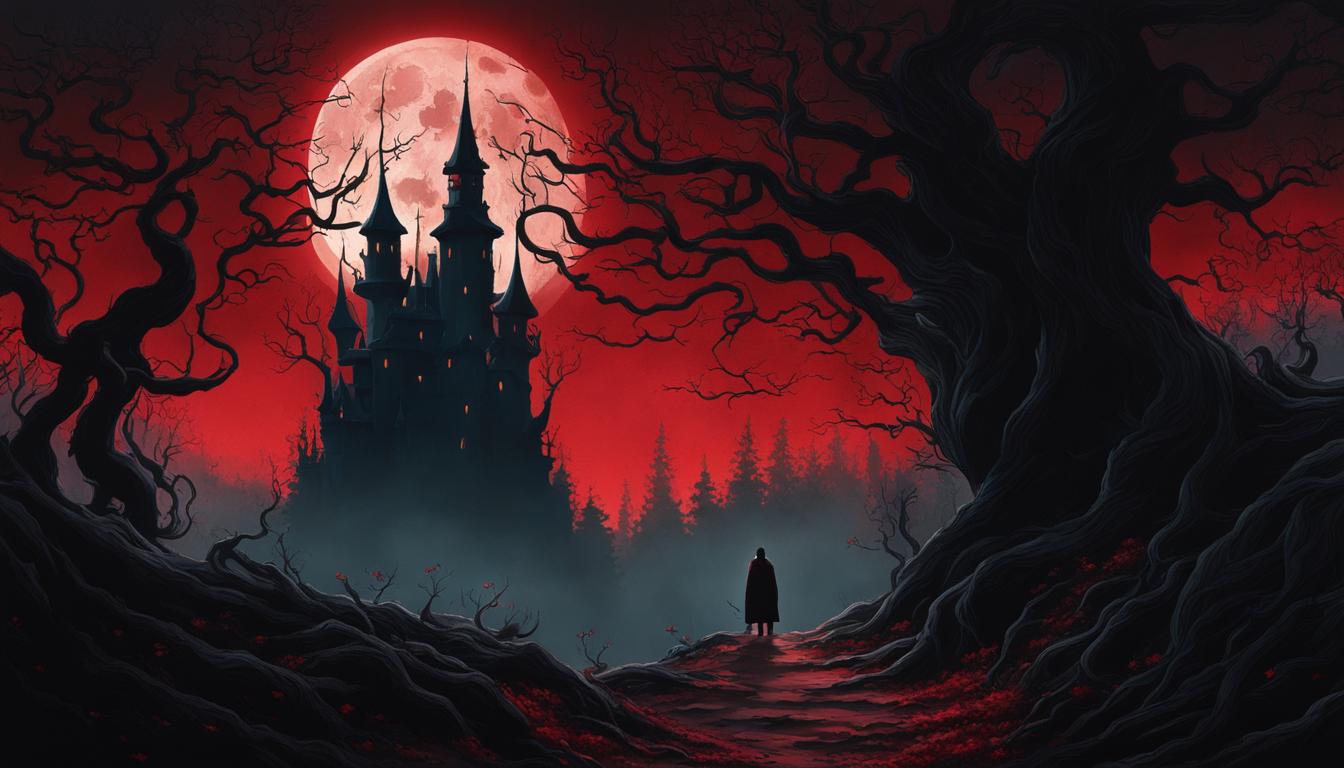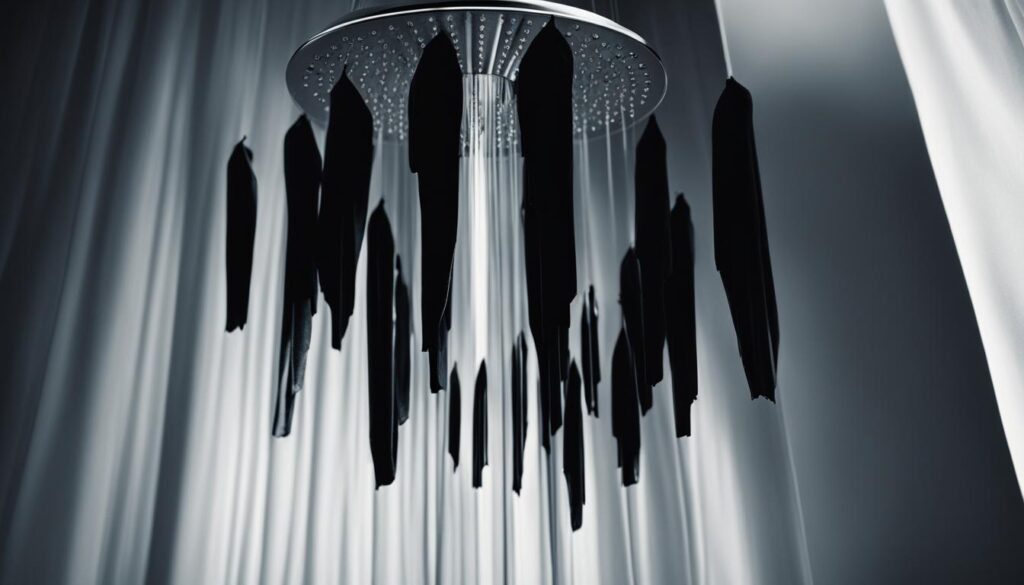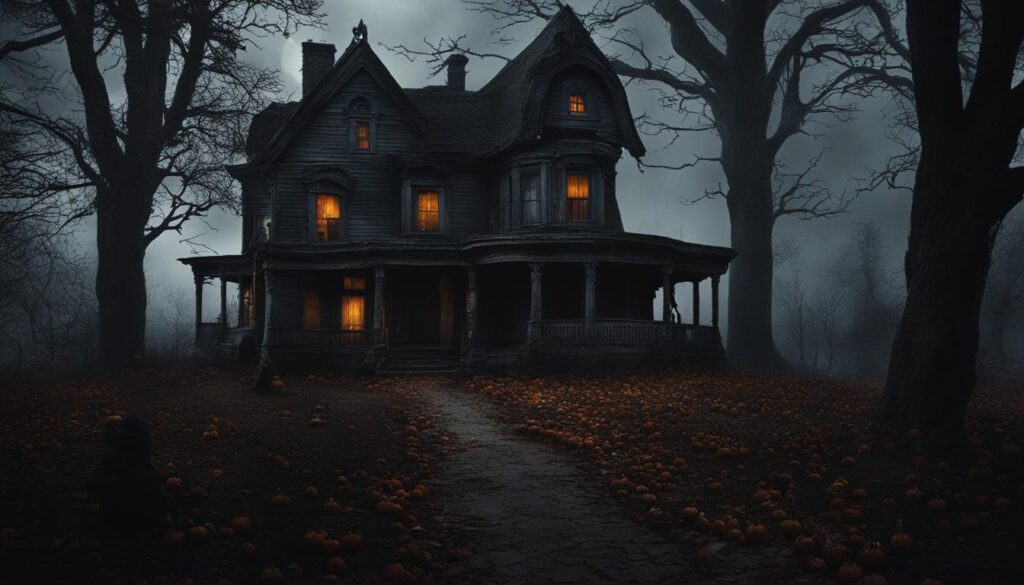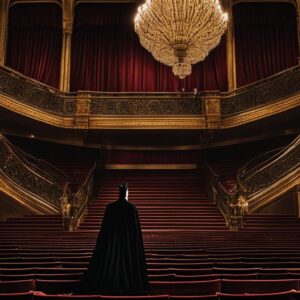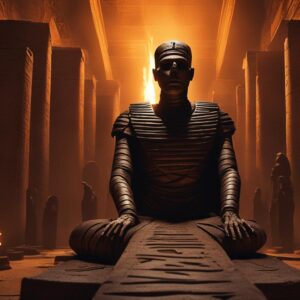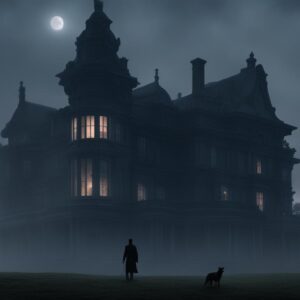As a horror film enthusiast, I often find myself diving deep into the dark and captivating world of Italian horror. One film that has always stood out to me is the cult classic, Black Sunday (1960). Directed by Mario Bava and starring Barbara Steele, this gothic horror masterpiece has left an indelible mark on the genre.
Key Takeaways:
- Black Sunday (1960) is a cult classic Italian horror film directed by Mario Bava.
- The film stars Barbara Steele and is known for its gothic horror aesthetic.
- Black Sunday (1960) has had a lasting impact on the genre and is considered one of Bava’s early masterpieces.
- The film’s haunting atmosphere and powerful performances make it a must-watch for horror fans.
- Black Sunday (1960) is a testament to the enduring legacy of Italian horror cinema.
The Shocking Year of 1960 in Horror Films
The year 1960 was a pivotal time for the horror film genre, as it saw the release of several groundbreaking and shocking movies that would leave a lasting impact on audiences and push the boundaries of the genre. These films explored new levels of violence, psychological terror, and ritualistic killers, challenging the conventions of horror cinema.
One of the most notable films from this era is Psycho, directed by Alfred Hitchcock. This psychological thriller shocked audiences with its iconic shower murder scene and introduced a new level of suspense and tension to the genre. Another influential film from 1960 is Eyes Without a Face, directed by Georges Franju. This haunting French horror film delved into themes of identity and surgical horror, offering a unique and unsettling experience for viewers.
Other notable films from the year include Peeping Tom, directed by Michael Powell, which focused on a psychopathic killer who films his victims’ reactions, and Black Sunday, directed by Mario Bava, which showcased a chilling story of witchcraft and satanic rituals. These films, along with the growing popularity of giallos, a subgenre of Italian horror, helped define the horror landscape of the 1960s and set the stage for future advancements in the genre.
| Film | Director | Main Theme |
|---|---|---|
| Psycho | Alfred Hitchcock | Psychological terror |
| Eyes Without a Face | Georges Franju | Surgical horror |
| Peeping Tom | Michael Powell | Voyeurism and psychopathy |
| Black Sunday | Mario Bava | Ritualistic killings |
Psycho (1960)
“A masterpiece of suspense and psychological terror, Hitchcock’s Psycho forever changed the horror genre with its shocking narrative and iconic shower murder scene.” – Roger Ebert
The release of these groundbreaking horror films in 1960 marked a turning point in the genre, pushing boundaries and opening up new possibilities for filmmakers to explore. These films laid the foundation for future classics and continue to be influential in shaping the horror landscape today.
Mario Bava’s Gothic Throwback: Black Sunday
When discussing the influential horror films of the 1960s, it’s impossible to overlook Mario Bava’s gothic masterpiece, Black Sunday. Released in 1960, this Italian horror film captivated audiences with its striking visuals and chilling storyline. Directed by Bava and featuring the talented Barbara Steele in the lead role, Black Sunday transported viewers to a world of dark magic and ancient curses.
The film’s opening sequence is particularly memorable, showcasing Bava’s meticulous attention to detail and his ability to create a haunting atmosphere. Princess Asa, played by the mesmerizing Barbara Steele, is convicted of witchcraft and has a satanic mask nailed onto her face. This unforgettable scene sets the tone for the rest of the film, immersing viewers in a nightmarish tale of revenge and redemption.
Black Sunday pays homage to the gothic horror style popularized by Hammer Films, known for their atmospheric settings and brooding characters. Bava’s directorial choices, combined with Steele’s captivating performance, make Black Sunday a timeless classic that continues to resonate with horror enthusiasts today. Its influence on the genre cannot be underestimated, inspiring future filmmakers to explore the depths of gothic terror.
Mario Bava: Master of Italian Horror
Mario Bava, often referred to as the “father of Italian horror,” was a visionary director known for his unique blend of suspense, atmosphere, and gore. With films like Black Sunday, Bava established himself as a master of the genre, paving the way for future horror filmmakers to push boundaries and challenge conventional storytelling.
Bava’s use of innovative camera techniques, striking visuals, and intricate storytelling captivated audiences and solidified his place in horror cinema history. His contributions to the genre continue to be celebrated and studied by film enthusiasts around the world.
| Mario Bava’s Gothic Throwback: Black Sunday | Mario Bava: Master of Italian Horror |
|---|---|
| Gothic horror | Unique blend of suspense, atmosphere, and gore |
| Barbara Steele’s captivating performance | Innovative camera techniques and striking visuals |
| Inspired by Hammer Films | Pioneered the genre and influenced future filmmakers |
Eyes Without a Face: Eerie and Unsettling
Eyes Without a Face, directed by Georges Franju, is a haunting film that explores themes of identity and surgical horror. The story revolves around a plastic surgeon who tries to restore his daughter’s disfigured face by abducting women and transplanting their skin onto her. The film’s eerie atmosphere and the ghost-like presence of the daughter make it a unique and unsettling watch.
Franju’s direction in Eyes Without a Face is masterful, creating a sense of unease and tension throughout the film. The black and white cinematography adds to the haunting visuals, emphasizing the nightmarish quality of the story. The ghost-like presence of the daughter, who wears a mask to hide her disfigurement, adds to the eerie atmosphere and leaves a lasting impression on the viewer.
The surgical horror elements in Eyes Without a Face are both disturbing and thought-provoking. The film explores the ethical implications of the surgeon’s actions and delves into the consequences of his desperate attempts to restore his daughter’s beauty. The graphic scenes of surgery are visceral and shocking, adding to the overall sense of unease and horror.
Eyes Without a Face: A Cinematic Masterpiece
“The face you deserve” – Dr. Génessier
Eyes Without a Face is a chilling and unforgettable film that delves deep into the darkest corners of the human psyche. Franju’s masterful direction, combined with the haunting performances and the surgical horror elements, creates an unsettling experience that lingers long after the film ends.
Overall, Eyes Without a Face is a true masterpiece of horror cinema. Its eerie atmosphere, ghost-like presence, and thought-provoking exploration of identity and surgical horror make it a must-watch for fans of the genre. This film’s enduring impact and thematic depth solidify its place as one of the most unsettling and powerful horror films ever made.
| Director | Release Year | Genre |
|---|---|---|
| Georges Franju | 1960 | Horror |
Peeping Tom: A Shocking and Controversial Film
Peeping Tom, directed by Michael Powell, is a shocking and controversial film that delves into the dark depths of voyeurism and the twisted mind of a psychopathic killer. Released in 1960, this British thriller explores the destructive effects of filmmaking on the human psyche, highlighting the blurred lines between reality and the haunting world of cinema.
The film follows Mark Lewis, a young man who works as a cameraman by day and indulges in secret, sadistic activities by night. Using his camera as a weapon, Mark captures the terror and suffering of his victims, immersing viewers in their horrifying final moments. Peeping Tom challenges societal norms and forces us to confront our own voyeuristic tendencies, questioning the morality of not only the on-screen actions but also our own fascination with violence.
“All this filming isn’t healthy. You can ask anyone.”
Peeping Tom was met with widespread controversy upon its release, criticized for its explicit portrayal of violence and sexual deviance. The film was so shocking to audiences that it was pulled from theaters and effectively ended Powell’s career as a respected filmmaker. However, over time, Peeping Tom has earned its place as a cult classic and is now recognized for its bold exploration of psychological horror and the dark, disturbing nature of human obsession.
| Key Details | Peeping Tom |
|---|---|
| Director | Michael Powell |
| Release Year | 1960 |
| Genre | Psychological Thriller |
| Themes | Voyeurism, Psychopathy |
| Legacy | Cult Classic |
Psycho: Hitchcock’s Cinematic Masterpiece
When it comes to iconic scenes in horror films, one of the first that comes to mind is the shower murder in Alfred Hitchcock’s Psycho. This infamous scene, lasting only a few minutes, has become etched in the collective memory of audiences around the world. The combination of Hitchcock’s masterful direction, the shocking violence, and the psychological terror it evokes has solidified Psycho as a cinematic masterpiece.
The shower murder scene in Psycho is a prime example of Hitchcock’s ability to create suspense and terror through visual storytelling. The rapid cuts, close-ups, and eerie music build tension and keep viewers on the edge of their seats. The suddenness and brutality of the murder, combined with the vulnerability of the victim in the shower, creates a sense of helplessness and fear that continues to resonate with audiences today.
“There is no terror in the bang, only in the anticipation of it.” – Alfred Hitchcock
Psycho also introduced innovative techniques and narrative twists that were ahead of their time. By killing off the film’s apparent protagonist early on, Hitchcock subverted audience expectations and kept them guessing until the very end. The revelation of Norman Bates’ split personality and his transformation into his mother added an extra layer of psychological complexity to the story, leaving a lasting impact on viewers.
Psycho’s influence on the horror genre cannot be overstated. It paved the way for a new wave of psychological thrillers and inspired countless filmmakers to explore the depths of human psyche in their own work. The shower murder scene, in particular, has become a symbol of the power of cinema to shock and disturb, solidifying Psycho’s place in film history.
The Power of Iconic Scenes
Iconic scenes like the shower murder in Psycho are not only memorable, but they also shape the way we think about and remember films. These scenes become cultural touchstones, referenced and parodied in countless other media, and forever etched in our collective consciousness. They remind us of the power of cinema to elicit visceral emotions and leave a lasting impact on audiences.
The Innocents: A Visually Stunning Ghost Tale
The Innocents is a visually stunning ghost tale that uses black and white cinematography to create an eerie and unsettling atmosphere. The film, released in 1961 and directed by Jack Clayton, is based on Henry James’ 1898 novella “The Turn of the Screw.” It centers around a governess, played by Deborah Kerr, who believes that the house she cares for is haunted and that the children she looks after are being possessed.
The Innocents is known for its exquisite cinematography, which captures the haunting beauty of the English countryside and the decaying splendor of the gothic mansion. The use of black and white enhances the film’s sense of mystery and darkness, creating a visual experience that is both captivating and atmospheric.
“Are you imagining things, Miss? Or are you quite sure there was someone? There was someone, wasn’t there? Yes! Yes, there was someone!” – The Innocents
The film explores themes of psychological horror, blurring the lines between reality and imagination. As the governess becomes increasingly convinced of the malevolent presence in the house, tension mounts, and the audience is left to question what is real and what is a figment of the protagonist’s imagination.
Governess and Ghosts: The Psychological Depths of The Innocents
The Innocents delves into the psychological depths of its characters, particularly the governess. As she grapples with her own fears and insecurities, her perception of reality becomes increasingly distorted. The boundary between the supernatural and the human world blurs, leaving the audience to wonder whether the ghosts are real or mere manifestations of the governess’ troubled mind.
The Innocents is a haunting masterpiece that combines stunning visuals, psychological depth, and atmospheric storytelling. It continues to be celebrated as a classic ghost tale and a prime example of the power of black and white cinematography in creating a captivating and chilling cinematic experience.
The Birds: Hitchcock’s Home Invasion Horror
Alfred Hitchcock’s The Birds is a masterful example of home invasion horror, where the terror comes not from a masked killer or supernatural entity, but from nature itself. Released in 1963, this iconic film follows the residents of a small coastal town as they are inexplicably and relentlessly attacked by swarms of birds. Hitchcock skillfully builds tension throughout the film, using primitive technology to create realistic and horrifying bird attack scenes that still resonate with audiences today.
One of the most memorable aspects of The Birds is Hitchcock’s ability to create masterful moments of suspense. From the opening scene at a San Francisco pet shop, where birds eerily gather and silently watch, to the shocking attack sequences that leave viewers on the edge of their seats, Hitchcock expertly crafts a sense of dread and uncertainty. The film’s use of sound design, including the absence of a traditional musical score, adds to the eerie atmosphere and heightens the viewer’s unease.
“Why are they doing this? Why are they doing this? They said when you got here, the whole thing started. Who are you? What are you? Where did you come from? I think you’re evil. EVIL!” – Mitch Brenner, The Birds
While The Birds may not have aged as flawlessly as some of Hitchcock’s other classics, its enduring power lies in the unsettling concept of a seemingly mundane and everyday occurrence turning into a nightmare. The film serves as a reminder that even the most familiar elements of our environment can become sources of terror. Through Hitchcock’s expert direction and masterful storytelling, The Birds remains a chilling and memorable entry in the horror genre.
| Hitchcock’s Home Invasion Horror: The Birds | Director | Release Year |
|---|---|---|
| Summary | Alfred Hitchcock | 1963 |
| Plot | The residents of a small coastal town are inexplicably attacked by swarms of birds. | – |
| Terror | Nature itself becomes the source of horror. | – |
| Suspense | Masterful moments of tension and uncertainty. | – |
You Must Remember This: Unlocking Old Hollywood’s Secrets
You Must Remember This is a captivating podcast that takes listeners on a journey through the intriguing and often scandalous stories of Old Hollywood. Hosted by the talented Karina Longworth, the podcast serves as a treasure trove of knowledge, uncovering the hidden secrets and legends of classic films and the glamorous stars who brought them to life. From the scandals of the silent era to the golden age of cinema, You Must Remember This provides a fascinating insight into the captivating world of Old Hollywood.
Karina Longworth’s passion for and extensive knowledge of Old Hollywood shines through in every episode of You Must Remember This. With meticulous research and detailed storytelling, she brings to light lesser-known actors, forgotten films, and behind-the-scenes anecdotes that provide a deeper understanding of the history and impact of classic films. Each episode is like a time capsule, transporting listeners back to a bygone era filled with glamour, intrigue, and larger-than-life personalities.
Old Hollywood holds a special place in the hearts of film enthusiasts, and You Must Remember This captures the essence of this era with its engaging narratives and rich storytelling. Whether you’re a seasoned cinephile or just beginning your journey into classic cinema, the podcast offers a captivating and educational experience that will leave you craving more Hollywood lore.
“You Must Remember This is an invaluable resource for anyone interested in the fascinating history of Old Hollywood. Karina Longworth’s passion for the subject shines through in every episode, making it a must-listen for film enthusiasts.” – Film Fanatic Magazine
Halloween: The Birth of a Genre
When discussing iconic horror films, one cannot overlook the groundbreaking impact of Halloween. Directed by John Carpenter and released in 1978, Halloween is widely regarded as the film that birthed the slasher genre as we know it today. The movie introduced audiences to the iconic masked killer, Michael Myers, and set the template for countless horror movies that followed.
What sets Halloween apart is its ability to create an atmosphere of relentless suspense and fear. Carpenter’s masterful direction, combined with the haunting score that he composed himself, keeps viewers on the edge of their seats throughout the film. The suspense is heightened by the fact that Michael Myers seems to be an unstoppable force, lurking in the shadows and striking fear into the hearts of both characters and audiences alike.
The character of Michael Myers, with his blank expression and haunting presence, has become one of the most iconic figures in horror cinema. The mask he wears, a modified William Shatner mask painted white, has become synonymous with the Halloween franchise and the slasher genre as a whole.
With its chilling atmosphere, suspenseful storytelling, and the introduction of an iconic masked killer, Halloween remains a cultural phenomenon that continues to captivate audiences and inspire filmmakers today.
The Enduring Legacy of the Halloween Franchise
The success of the original Halloween film in 1978 led to the creation of a long-running franchise that has captivated audiences for decades. With its iconic masked killer, Michael Myers, at the helm, the Halloween franchise has spawned numerous sequels, remakes, and reboots, each offering its own unique take on the slasher genre.
The Halloween franchise has become synonymous with the horror genre, solidifying its place in pop culture. Fans worldwide eagerly anticipate each new installment, eager to see how the story of Michael Myers unfolds. From his chilling encounters with unsuspecting victims to his unbreakable bond with psychiatrist Dr. Loomis, the franchise has created a rich and complex mythology around its central character.
Over the years, the Halloween franchise has evolved, exploring different timelines and reinterpretations of the original story. Some sequels delve deeper into Michael Myers’ motivations, while others embrace the senselessness and unpredictability of his actions. The franchise has also seen its fair share of remakes and reboots, breathing new life into the iconic horror tale.
| Film | Year | Director |
|---|---|---|
| Halloween II | 1981 | Rick Rosenthal |
| Halloween III: Season of the Witch | 1982 | Tommy Lee Wallace |
| Halloween 4: The Return of Michael Myers | 1988 | Dwight H. Little |
| Halloween (2007) | 2007 | Rob Zombie |
Despite the passage of time, the Halloween franchise remains as relevant and terrifying as ever. Its enduring legacy is a testament to the power of Michael Myers and the enduring fascination with his character. With each new installment, the Halloween franchise continues to captivate audiences, ensuring that the masked killer’s reign of terror will live on for years to come.
Unmasking the Horror: Exploring the Origins of Michael Myers
When it comes to iconic horror villains, few can match the chilling presence of Michael Myers. The masked killer has become a staple of the Halloween franchise, terrorizing audiences for decades. But what drives this enigmatic figure? What are his motivations and the origins of his evil?
Michael Myers, often referred to as “The Shape,” made his debut in the 1978 film Halloween, directed by John Carpenter. In the original film, Michael is portrayed as a seemingly unstoppable force of evil, with no clear motivations for his violent acts. The lack of a rational explanation for his actions only adds to his terrifying mystique, leaving audiences to speculate on the nature of his true character.
Over the years, as the Halloween franchise expanded with sequels and reboots, attempts have been made to delve into Michael’s backstory and provide more concrete explanations for his behavior. Different films have offered various interpretations, introducing elements such as familial connections, supernatural forces, and psychological trauma to shed light on the birth of evil within Michael Myers.
“He had the blackest eyes…the devil’s eyes.” – Dr. Sam Loomis, Halloween (1978)
Despite these attempts to rationalize the senseless violence of Michael Myers, the character remains shrouded in ambiguity. Perhaps it is the very mystery surrounding him that makes him so terrifying. By keeping his motivations unknown, Michael becomes an embodiment of pure evil, an unstoppable force that embodies our collective fears.
In conclusion, the origins of Michael Myers in the Halloween franchise have been explored and reimagined over the years. While the original film presents him as a motiveless killer, subsequent installments have attempted to uncover the roots of his evil. However, the true nature of Michael Myers remains elusive, leaving his character open to interpretation and ensuring his reign of terror continues to captivate audiences.
The Rationalizing of the Senseless: The Storytelling in Halloween Franchise
When it comes to the Halloween franchise, storytelling plays a crucial role in rationalizing the senseless and bringing depth to the horror. The original film introduced audiences to the enigmatic and unstoppable killer, Michael Myers, whose actions seemed random and devoid of motive. As subsequent films explored his origins and delved into his twisted psyche, the franchise sought to rationalize the horrors he unleashed.
By providing explanations and delving into the motivations of Michael Myers, the Halloween franchise adds layers of complexity to the senseless violence of the original film. It delves into themes of familial connections, supernatural forces, and the birth of evil, attempting to make sense of the seemingly irrational actions of its iconic masked killer.
“The Halloween franchise takes the concept of the senseless killer and transforms it into a deeply psychological exploration of the human condition,” says horror film expert Dr. Emily Collins. “Each new installment attempts to rationalize Michael Myers’ actions, offering different interpretations that tease audiences with answers while leaving room for mystery.”
While some fans appreciate the deeper exploration of Michael Myers’ character and the rationalization of his actions, others argue that the senselessness of the original film is what made it so terrifying. The attempts to explain and rationalize his motivations can potentially strip away the horror and make the franchise lose some of its mystique.
| Aspect | Rationalization | Senselessness |
|---|---|---|
| Horror Impact | Provides a deeper understanding of the character | Leaves room for imagination and fear |
| Character Complexity | Offers different interpretations and motivations | Portrays Michael Myers as an enigmatic force of evil |
| Genre Evolution | Expands the narrative possibilities of the franchise | Maintains the original film’s groundbreaking concept of terror |
The storytelling choices in the Halloween franchise have sparked debates among fans and critics alike. However, what remains undeniable is the enduring impact of the original film and its contribution to the horror genre. Whether through rationalization or senselessness, the Halloween franchise continues to captivate audiences and terrify viewers with its iconic masked killer.
Conclusion
In conclusion, Black Sunday (1960) and the horror films of its era have left an indelible mark on the genre, shaping it into what it is today. Mario Bava’s gothic masterpiece, along with other influential films like Psycho, Eyes Without a Face, and Peeping Tom, pushed the boundaries of horror storytelling and introduced new levels of violence and psychological terror.
The legacy of Black Sunday and its contemporaries can be seen in the way horror films continue to captivate and shock audiences. These films paved the way for the evolution of the genre, inspiring future classics and redefining the boundaries of what is considered horrifying.
Mario Bava’s visionary direction in Black Sunday, along with the unforgettable performances of actors like Barbara Steele, have solidified the film’s status as a cult classic in the pantheon of horror. Its gothic horror aesthetic and timeless storytelling continue to resonate with audiences, making it a must-watch for horror enthusiasts.
The Halloween franchise, with its iconic masked killer and enduring legacy, serves as a testament to the lasting impact of the horror films of the 1960s. These films set the stage for the evolution of horror storytelling, influencing subsequent generations of filmmakers and leaving an indelible mark on the genre. The legacy of Black Sunday and its contemporaries will continue to shape the future of horror cinema for years to come.
FAQ
What is Black Sunday (1960) about?
Black Sunday is a cult classic horror film directed by Mario Bava and starring Barbara Steele. It is known for its gothic horror aesthetic and its enduring impact on the genre.
What other notable horror films were released in 1960?
Other groundbreaking horror films released in 1960 include Psycho, Eyes Without a Face, Peeping Tom, and Black Sunday. These films shocked audiences and pushed the boundaries of the genre.
Who directed Black Sunday?
Black Sunday was directed by Mario Bava, an influential figure in Italian horror cinema.
Who stars in Black Sunday?
Barbara Steele, known for her captivating performances in gothic horror films, stars in Black Sunday.
What is the plot of Black Sunday?
Black Sunday follows the story of Princess Asa, played by Barbara Steele, who is convicted of witchcraft and has a satanic mask nailed onto her face. The film explores themes of witchcraft, revenge, and the supernatural.
What is the legacy of Black Sunday?
Black Sunday is considered one of Mario Bava’s early masterpieces and has had a lasting impact on the horror genre. It is praised for its atmospheric style and chilling visuals.
What is the Halloween franchise?
The Halloween franchise is a series of horror films centered around the iconic masked killer, Michael Myers. It started with the 1978 film Halloween, directed by John Carpenter.
Who directed Halloween?
The original Halloween film was directed by John Carpenter.
What is the significance of Halloween in the horror genre?
Halloween is considered the birth of the slasher genre and remains one of the most influential horror films of all time. It introduced the iconic masked killer, Michael Myers, and set the template for countless horror movies that followed.
How many films are there in the Halloween franchise?
The Halloween franchise includes multiple sequels, remakes, and reboots. It has expanded over the years to include various installments that explore different aspects of Michael Myers’ story.
How has the character of Michael Myers evolved in the Halloween franchise?
The character of Michael Myers has undergone various reinterpretations and retcons throughout the Halloween franchise. Each film offers a different perspective on his origins, motivations, and the horrors he unleashes.
What is You Must Remember This?
You Must Remember This is a popular podcast hosted by Karina Longworth that delves into the secrets and stories of Old Hollywood. It explores the history, scandals, and impact of classic films and the people behind them.
Who hosts You Must Remember This?
You Must Remember This is hosted by Karina Longworth, a renowned film critic and researcher known for her meticulous attention to detail and in-depth knowledge of Old Hollywood.
What is the main focus of You Must Remember This?
You Must Remember This brings lesser-known actors and behind-the-scenes stories to the forefront, shedding light on the secrets and untold tales of Old Hollywood.

